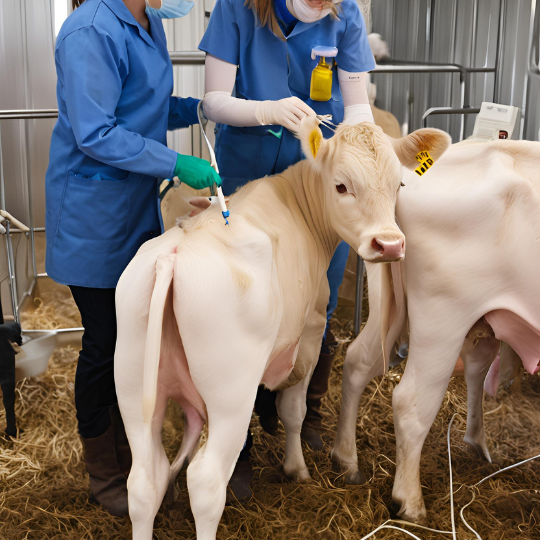Welcome to the dark side of beef, where the juicy allure of a perfect steak hides a world of unsettling truths. When we sink our teeth into that mouthwatering meat, few of us stop to ponder the unsettling secrets hidden beneath its surface. From the crowded feedlots where cows live in squalor to the alarming overuse of antibiotics and hormones, the journey from pasture to plate is filled with shocking truths that most would prefer to ignore. So, let’s pull back the curtain and dive into the murky depths of what really goes into our favorite cuts of meat.
The Beginning: From Birth to Feedlot
Calfhood Management: The Start of a Hard Life and the Dark Side of Beef
When calves are born, they face a tough future. Right out of the womb, many calves are given antibiotics to prevent disease. About 80% of all antibiotics sold in the U.S. are used in livestock because cattle are often raised in crowded conditions.
- Shock Factor: These calves aren’t just getting a little bit of medicine; they’re being pumped full of drugs from the start. This overuse of antibiotics can lead to antibiotic-resistant bacteria, which is a huge threat to public health. The CDC reports that 2 million people in the U.S. get infected with antibiotic-resistant bacteria every year [1]. These infections are not only harder to treat but can also lead to longer hospital stays and increased healthcare costs.
The Hormonal Factor: Growth at What Cost?
Next up in the dark side of beef production are growth hormones. Cattle are dosed with synthetic hormones like estradiol, progesterone, and testosterone to make them grow faster. This lets cattle gain up to 3 pounds a day!
- Health Concerns: While the FDA says these hormones are safe, growing research links them to an increased risk of certain cancers, like breast and prostate cancer. Early exposure to these hormones can mess with human development and lead to hormonal imbalances in adults. Notably, a study published in the Journal of Applied Animal Research found that exposure to estrogen from various sources could elevate breast cancer risk in women among other things [4].
Feedlot Life: Cramped Conditions
Most cattle spend their final months in feedlots, crammed in with thousands of other cows. Furthermore; cattle in feedlots do not exceed 30 months in age! It’s like a factory setting, where animals often stand in their own waste. This leads to stress and disease, prompting feedlot management to use even more antibiotics.
- Shock Factor: The average feedlot houses 20,000 cattle! This can lead to rampant disease. To combat this, feedlot workers are instructed to feed cattle a grain-based diet that includes corn. Which is something they aren’t designed to digest. This diet contributes to stomach issues making cattle more prone to infections and needing more antibiotics [1].
Diet Disaster: The Grain Problem
Cattle raised on a grain-based diet can experience acidosis, a painful condition caused by eating too much grain. This unnatural diet can lead to bloating and even death.
- Impact on Humans: The dark side of eating beef from stressed and poorly fed cattle can lead to lower-quality meat. As well as, possibly expose you to harmful bacteria and chemicals used in the feedlot. The CDC has linked the consumption of meat from stressed animals to the transmission of pathogens like E. coli and Salmonella. These pathogens can cause serious foodborne illnesses [1].
The Dark Side of Beef: The Controversial “Pink Slime”
Now, let’s talk about the infamous pink slime, officially known as lean finely textured beef (LFTB). This product is made from leftover beef trimmings. Then processed in a way that allows it to be added back into ground beef to make it leaner and cheaper.
- Production Process: What Goes Into Pink Slime?
Pink slime is made from the leftover bits of meat. These trimmings are treated with ammonium hydroxide or citric acid to kill pathogens! Resulting in a product that looks like a pinkish paste.
- Shock Factor: At its peak, pink slime was used in about 70% of ground beef sold in U.S. grocery stores. Furthermore, when you buy ground beef labeled simply as “beef,” you might be eating something with a significant amount of pink slime.
- Health Concerns and Controversy
The use of pink slime became a hot topic in 2012, leading to a public outcry. Critics raised concerns about the safety of eating a product made from leftover trimmings treated with ammonia.
- Impact on Humans: Studies have shown that consuming processed meats with fillers like pink slime can increase the risk of various health issues, including cancer. Also, according to the World Health Organization (WHO); processed meats, including those containing pink slime, are classified as Group 1 carcinogens. meaning they can cause cancer in humans [2]. Plus, the presence of ammonia may irritate your stomach and cause other digestive issues.
Additives and Preservatives: The Dark Side of Beef Dangers
Once cattle are slaughtered, the meat is often treated with various additives and preservatives that can have serious health implications.
Beta-Agonists: Performance Enhancers
Beta-agonists, like ractopamine, are drugs used to promote muscle growth and reduce fat. Moreover, these drugs may boost profits, but they also come with side effects to both cows and humans.
- Shock Factor: Cattle treated with ractopamine have shown signs of tremors and increased heart rates. Therefore; this raises concerns about animal welfare and possible health risks for us. Furthermore, the FDA has approved ractopamine, but several countries have banned it due to health concerns related to human consumption.
Preservatives and Their Effects
Did you know that processed beef products contain preservatives like nitrites and nitrates. With that being said; these chemicals are being added to keep meat looking fresh and inhibit bacterial growth! However, they can form nitrosamines when cooked at high temperatures, which are known carcinogens.
- Impact on Humans: Moreover, eating processed meats with these preservatives has been linked to higher risks of colorectal cancer and other health problems. There was a study published in the World Health Organization (WHO). In that study, they found that eating more nitrite-rich processed meats significantly increased the risk of colorectal cancer [2].
Slaughtering Practices: Not for the Faint of Heart
The slaughter process also leaves much to be desired, both ethically and from a health perspective.
- Inhumane Slaughter Conditions: Cattle are often not stunned improperly before slaughter, which can lead to extreme stress and a condition known as dark-cutting beef, negatively affecting meat quality.
- Shock Factor: Many slaughterhouses use methods that are not only cruel but can also compromise the safety and quality of the meat. Stressed animals produce meat that is tougher and less enjoyable to eat. Furthermore, stress hormones released during slaughter can change the flavor and texture of the meat [1].
- Carbon Monoxide Packaging: Once the beef is processed, it’s often treated with carbon monoxide to keep it red and looking fresh.
- Shock Factor: The USDA allows this treatment, so when you think you’re buying fresh meat, you might be getting something that’s been artificially preserved. While carbon monoxide is considered safe by regulatory agencies, it masks the true freshness of the meat, misleading consumers about its quality [1].
The Bigger Picture: Environmental and Health Impacts
Beyond the direct implications for your health, the beef industry has broader environmental consequences that can affect you and future generations.
Resource Drain
Raising cattle requires huge amounts of water and land. But when done in the right way it promotes not only healthier cows. Moreover, it also increases the health of the land.
- Shock Factor: It takes about 1,800 gallons of water to produce just one pound of beef when they are raised in the feedlots! With climate change becoming a big issue, the environmental impact of big beef production cannot be ignored. Plus, methane emissions from cattle significantly contribute to greenhouse gases, worsening global warming. (Because of this alone you may want to read more about Regenerative Farming!)
Public Health Concerns
Another dark side of the beef industry is the overuse of antibiotics and hormones in livestock. This can also be directly linked to the public health crises. The rise of antibiotic-resistant bacteria is one of the most pressing health threats in today’s society.
- Impact on Humans: Did you know eating meat loaded with these resistant bacteria can make you more vulnerable to infections that are tough to treat? Infections from antibiotic-resistant bacteria can lead to longer hospital stays, higher medical bills, and even more deaths [1].
Even Darker Side is the Health Concerns: Chemical-Laden Beef and Its Impact on Humans
- Chemical Residues in Meat: The chemicals used in beef production can stick around and pose risks to our health. Hormones and antibiotics can linger in the meat, leading to unintended consequences when we eat it.
- Long-Term Effects: Eating hormone-laden beef regularly has been linked to developmental issues in kids, like precocious puberty. Research has suggested that early exposure to estrogen from beef can disrupt our hormones and lead to imbalances in both boys and girls [3].
- Gut Health and Microbiome Disruption: Eating beef treated with antibiotics can disrupt our gut microbiome, which is the community of microorganisms living in our digestive systems. This can lead to various health problems, such as:
- Increased Risk of Obesity: Changes in gut bacteria can affect how our bodies regulate weight and might contribute to obesity.
- Digestive Disorders: An imbalance in gut flora can result in digestive issues like irritable bowel syndrome (IBS) and other gastrointestinal problems.
- Autoimmune Diseases: A disrupted microbiome has been linked to the rise of autoimmune diseases and allergies, as a healthy gut is crucial for proper immune function [2].
- Cardiovascular Health Risks: Regular consumption of red and processed meats has been linked to an increased risk of cardiovascular diseases. High saturated fat content in beef can lead to elevated cholesterol levels and heart problems.
- Shocking Stats: Research shows that people who eat more red and processed meats have a significantly higher risk of heart disease and stroke. The American Heart Association recommends cutting back on red meat to improve heart health.
In My Humble Opinion
We need to cut out All processed foods! We need to get to know our neighbors; as well as, our local farmers and ranchers. Find out what their crop and herd practices are and what they are doing with their products. Then start supporting those in your area that align with your beliefs. (Why do you think everyone wants Amish products? Stop and think about that one for a minute.) You will also want to look for those who believe in the Sustainable Beef Revolution! (Read more here!)
The big food producers of all kinds are putting additives and preservatives in everything we eat. Furthermore, we as a society have become sicker and fatter in the last 20-30 years. Take a minute and look around, we are less physically active but busier. We complain about the rising cost of groceries but we buy more processed foods or fast foods than we did 20-30 years ago.
I know for my sister and I, getting to eat out was an unexpected treat. Reserved for special occasions or while traveling. We had a few TV dinners or cans of Chef-boy-ardee in the pantry but that was for nights mom and dad had to work late. Or maybe for a quick bite before running out the door to catch a bus for a school activity. However, even the recipes on the “convenience” items of 30 years ago have changed. If you don’t believe me stick around. I will be diving deeper into the underbelly of the big food producers in the coming months.
Conclusion: Beefing Up Your Awareness
The U.S. beef industry is hiding a lot under the surface; from antibiotics and hormones to pink slime and shady slaughter practices. These factors don’t just affect the cows; they affect us, too. Read more about the Basics of U.S. Beef Production here.
So what can you do? Look for grass-fed, organic, and hormone-free beef whenever possible. By being mindful of what you eat, you can protect your health and take a stand against the harmful practices that make up much of the beef industry today. Want to get the best beef on the market that I have found go check out Delectable World of Nutrient Dense Beef!
Stay Informed and Beef Up Your Knowledge!
Join our Free email list to stay updated as we uncover and add new insights, tips, and tools to this site!
Believe me, we’re always researching, testing, and adding new finds—so don’t miss out!
Have Questions?
Reach out anytime about this or any other offers!
Sources:
- Centers for Disease Control and Prevention (CDC): Antibiotic Resistance Threats in the United States.
- World Health Organization (WHO): Carcinogenicity of the Consumption of Red Meat and Processed Meat.
- Journal of Clinical Endocrinology & Metabolism: Hormonal Factors and Breast Cancer.
- Journal of Applied Animal Research, 50(1), 426–439. Safety and concerns of hormonal application in farm animal production: a review.
Credible Sources for Further Reading
- U.S. Food and Drug Administration (FDA): Steroid Hormone Implants Used for Growth in Food-Producing Animals
- World Health Organization (WHO): Processed Meat and Cancer





